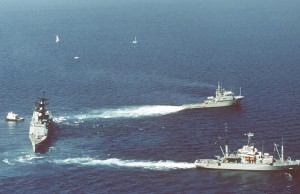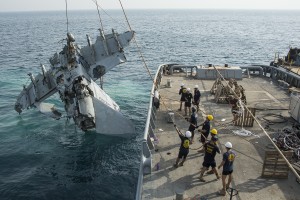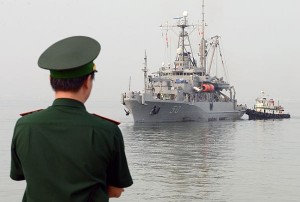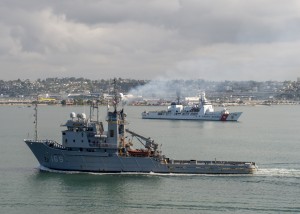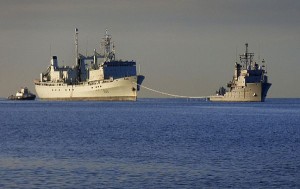 As the oil industry races to put modern platform support vessels and anchor handling ships into layup, the eight-ship “tug and salvage” T-ATS(X) program is getting kinda tough to justify. Why build new ships if the Navy can buy suitable hulls for far less?
As the oil industry races to put modern platform support vessels and anchor handling ships into layup, the eight-ship “tug and salvage” T-ATS(X) program is getting kinda tough to justify. Why build new ships if the Navy can buy suitable hulls for far less?
Right now there’s plenty of ships on the market that would make sensible candidates for a T-ATS(X) replacement. Read the Fall 2015 newsletter from Marcon International Inc, entitled, “OSVs on the Edge of the Abyss“, and you’ll understand why I’m all for buying a fleet of useful, cost-effective and tow-ready agents of (cough, cough) Distributed Lethality. Platform Support Vessels have never been so available:
In the Gulf, OSV tonnage by the veritable mile is now tied to the docks, and when there isn’t enough room quayside, many have dropped anchor out in the bay or up the nearest bayou. Some OSVs are in warm lay-up hoping for work while others are laid up “cold-iron” with all power off and doors chained and padlocked
If anything, the market for platform support vessels (PSV) has gotten more favorable for buyers over the past few months. And what’s even better is that the PSV market has plenty of never-used/newbuilding ships out there that stressed operators are looking to keep off their books. Heck, I think there are even a few ice-classed utility ships for sale that are ready for Polar service–for pennies on the dollar!
The prospect of buying a whole bunch of lightly-used oilfield support ships for cents on the dollar is hard to resist. The U.S. Navy might be thinking along similar lines. Last month the Navy released a little-noticed RFI to evaluate the purchase of up to nine existing platform support-like vessels.
Inside the Navy’s Justin Doubleday called to discuss that RFI, and I had the pleasure to tell him that the Navy would be wise to purchase a handful of these tough and useful “do anything” ships now, before oil prices come up and the evil ‘ole 2020s suck all the life out of naval procurement. The resulting story is behind a paywall, here, but I’ve got a few snippets I can discuss in a little more detail:
According to the sources sought notice, the Navy prefers buying U.S.-built ships classed by the American Bureau of Shipping, but the service will consider foreign-built ships classed by another organization, too. It adds that the Navy is seeking information vessels with a maximum age of 20 years.
According to Hooper, the Navy could be even more aggressive in pursuing newer ships commissioned within the last decade.
“Go for 10 years,” he said. “The market is big enough.”
As you can tell, there were a few things I didn’t like about the RFI. First, there’s no need to buy twenty-year-old platforms. 20-year-old platforms will be hard-used and, by 2030, they’re going to be falling apart. Let’s get platforms that can last beyond the 2020s.
Second, the Navy wanted to buy up to nine of these ships at the leisurely pace of two a year. I get it–the Navy can only absorb so many ships so quickly–but the best deals are going to be gotten now, while the price of oil is low. In four years, this glut of ships will have passed into memory. Buy ’em now, and slot them into the yards when possible.
And finally, there was no attempt to match the market with likely requirements. Everybody who might have a surplus platform supply vessel with an interesting value-added moon pool or helicopter deck or undersea crane or extra berthing spaces–or any operational goodies at all–is going to read “lowest cost” note, shrug, and take a pass, while every fly-by-night second-hand ship-dealer cackles with glee as they rush to propose their creaky, cruddy scrap-bound castoffs as the “lowest cost technically acceptable” solution. And then, once the Navy gets these rusty low-cost hulls, the MSC will turn around and spend a lot of money to modify, repair and, oh, add moon pools to ’em.
Don’t get me wrong, I like the minimum requirements list, but it might be smart to offer a few tailored RFIs shaped to meet some additional user requirements.
Those caveats aside, I’m really glad the MSC is putting aside the idea of privatizing this tug and salvage mission. Privatization has been proposed before, and I could see certain stressed owner/operator companies trying to propose similar schemes again:
Hooper said some commercial operators will suggest the Navy lease their vessels, rather than buying directly. But he advocates for buying the vessels outright.
“I just would caution the Navy that owning the vessels offers more flexibility for them and it gives them the extra security of having the asset and being able to control the asset itself,” Hooper said. “It might cost more but I think they would get their money’s worth if they purchase.”
Putting contracted ships in harm’s way is a recipe for trouble and will only generate business for maritime lawyers. Be glad the Navy has put aside the privatization option.
I have been a good friend of the T-ATS(X) program. I love the T-ATS(X). In fact, I wrote a large piece on the value of the tug and salvage fleet (Surface Navy: Don’t Defund the Salvage and Tug Fleet) advocating for the T-ATS(X) program. And all last year, though I don’t have skin in the game, I stumped for T-ATS(X), alienating all my friends who favor the more exotic “shooter” platforms (“if you fund a survivable ship, but can’t get those disabled ships off the battlefield, they’re…not survivable, right?”). Hopefully it helped. At any rate, somehow, somebody in Congress decided to accelerate the program, and the legislators put first-ship funding into the FY-16 budget.
The program certainly fills a potential shipbuilding hole–Marinette Marine built the Powhatan Class (T-ATF-166) Fleet Ocean Tugs, so my operating assumption was that the T-ATS(X) program would, in time, serve as a sort of “risk-reduction/off-ramp” consolation prize for the luckless yard that loses LCS business or a works program for stressed oil service-oriented shipyards.
Either way, a newbuild program would be most welcome.
And I’m all for it. So why not do both?
In the current security environment, the prospect of getting more boats quickly is hard to resist. I’d love to see the Navy build the T-ATS(X) AND pick up a lightly-used fleet of do-anything platform supply vessels.
According to Military Sealift Command (MSC) stats, the tug/salvage fleet are some of the most highly used/lowest cost platforms available to the Navy. The MSC can’t lose with these platforms.
The Navy yet may do both. There’s some room to maneuver. MSC has a fleet of nine chartered platform support vessels in their “Submarine and Special Warfare Support” division. So it would be a perfect time to recapitalize that fleet and let the “special” users have–for once–the convenience of operating from government property. There are real benefits.
Let’s just take one aspect–if the ships are US-owned, then special operators can put various comms, ISR and other “neat and integrated” modifications on the hulls, doing things that special operators just can’t do with a chartered vessel (one could even change the color scheme so they don’t “look Navy”, but there’s probably a rule against such practices).
And, as I said, above, right now there’s plenty of ships on the market that would make sensible replacements for the MSC’s shadowy fleet of nine chartered irregulars.
But the Navy needs to decide a few things first. Is the Navy up for maintaining two (or more) fleets of similar vessels? Why not combine the tug and salvage fleet and the Special Warfare Ship fleet under a single hullform family? The tug and salvage and the Special Warfare Ships have similarities and mission overlap. After all, the sub and special warfare mission profile holds some similarities with that of the Tug and Salvage fleet–I mean, the T-ATFs have housed Special Operators just as the Sub and Special Warfare platforms have lent a hand in rescue/salvage operations ranging from the USS Guardian (MCM-5) grounding to the location/confirmation of the Ehime Maru. Surely the primary users can modify a basic “class design” to suit their particular needs.
But that would mean years and years of design and delay (Yes, NAVSEA, I’m looking at YOU!). That’s why the Navy would be wise to pick a few interesting core requirements for certain missions and see if there are a few more specialized platforms out there that meet the particular missions of interest. As for the rest, well, to be honest, I think the Navy might be in for a bit of a surprise at just how many of these plain-jane commercial workboats offer some really neat modern gear.
Many of these commercial ships, Hooper continued, have also been built with modern technologies and advancements in areas such as the handling and recovery of small vessels.
“It’s an unparalleled opportunity,” Hooper said. “If you do a new build, there’s a chance that you have what should be very a simple and very cost effective platform becoming a larger, more expensive, unwieldy program that doesn’t field a ship for a while.”
Buying ships now gives America an opportunity to do a lot of things that just aren’t getting done. For the Navy, these good surplus ships can solve a whole host of presence, support, experimentation, and other pressing needs. Heck, kick in a few hulls for Admiral Rowden and his sailors will be shooting rockets and operating other LCS-esque modules off ’em in no time.
New missions are coming, and versatile ships from the oil patch can serve to mitigate risk. For example:
The role of recovering vehicles will only increase, Hooper says, as the military continues to experiment with unmanned technology.
“If history is any guide, the last time we had a technology advancement as big as unmanned vehicles was during the jet age,” he said in an April 7 interview with ITN. “Jets were crashing all over the place. It’s going to be the same thing with unmanned vehicle recovery.”
Frankly, we’re talking about more than just a salvage role here. Unmanned ships opens a new–and largely ignored–mission requirement for the Combat Logistics Force. All those fancy unmanned vessels we’re planning on launching and operating are great, but…they ain’t gonna tend themselves. To bend a time-honored logistical maxim, unmanned craft may not need beans, but they sure will need “black oil and bullets”. Stout oilfield supply-like platforms would be perfect for that mission.
Buying ships now gives America an opportunity to do more. They can support innovation–rather than waiting for an LCS or a DDG to test various new articles, use a spare PSV for early-stage experiments (Put a rail gun on it!) Use some for presence missions! Flood armed tugs into the South China Sea. No Maritime Militia is going to like rubbing up against a tough, armed PSV. And if Rowden wants to make every platform a shooter, then, well, let’s give him more platforms to shoot from.
At the end of the day, PSVs are practical, virtually disposable, and enormously useful. Let’s hope the Navy takes advantage of the oilfield slump, purchases a good handful, builds a few others, and sends them all off to handle the myriad of new missions that lurk in the seas of tomorrow.
